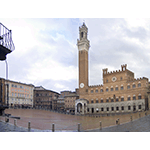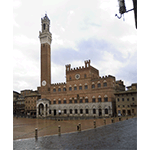Torre del Mangia [Mangia Tower]
To the left of the Palazzo Pubblico (Town Hall) stands the Torre del Mangia which, with its 88-metre height, symbolised communal freedom and the emancipation from feudal power. The first bell, by Florentines Riccardo di Tingo and his son Agostino, was set in place on the tower in 1347. The chronicles record the existence of a clock made in 1360 by Bartolomeo Guidi and restored before 1379 by Bernardino di Pietro from Rouen, and later by Don Gaspare degli Ubaldini. In 1425, the Jesuit Giovanni da Milano reconstructed it almost completely, modifying its entire clockwork. The hours were struck by an automaton initially made of wood (we know it existed already in 1396) and then of brass (1425).
In 1632, due to the bell’s defective sound, Antonio Ceranini from Novara made several unfortunate attempts to repair it. In 1665, it was decided to cast a new bell (the "Campanone"), entrusting Girolamo Santoni from Fano and Giovanni Battista Salvini from Siena with its realisation. The fusion process was carried out in the convent of San Francesco, lasting almost ten months, and was documented by Giovanni Maria Vieri. The bell was set in place (on September 23, 1666) with great difficulty, owing to its transportation and to the tower’s height. It took ten days and two large hoists operated by 53 men. Suffice it to consider that the bell weighed 6674 kilograms, was 1.98 metres high, and had a diameter of 2.34 metres.
****************************
Texts by Antonella Gozzoli
English translation by Victor Beard
Last update 22/feb/2008





